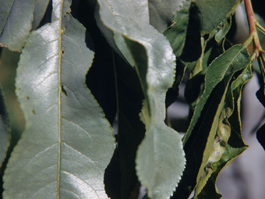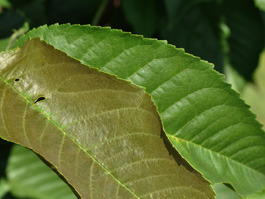by Elizabeth H. Beers and George N. Oldfield, originally published 1993
(Acari: Eriophyidae)
Plum nursery mite
Plum rust mite
Cherry rust mite
Aculus (Phyllocoptes) fockeui (Nalepa and Trouessart)
Peach silver mite
Aculus cornutus (Banks)
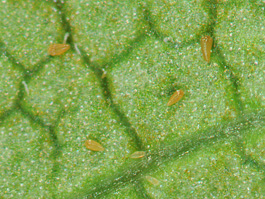
For about a century, since the original descriptions of the plum nursery mite and the peach silver mite, they have been considered separate species despite repeated assertions that they were indistinguishable. It was thought that the plum rust mite attacked European plum and cherry and the peach silver mite attacked peach. Recent evidence indicates that they are the same species but with a broader host range than previously reported. Thus, A. cornutus may be considered a synonym of A. fockeui, and their biology, life cycle and damage will be discussed together.
Prunus rust mites are widely distributed in the U.S. and Canada, probably wherever their hosts are grown.
Hosts
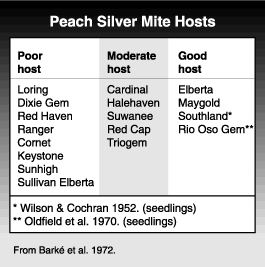 Hosts include European plum and myrobalan plum (also known as cherry plum), although injury on the latter is slight. Damson plums are particularly prone to damage. Japanese and American varieties of plums (e.g., P. hortulana, P. maritima, P. subcordata, P. virginiana melanocarpa) are incapable of supporting mite reproduction. P. avium (sweet cherry), P. cerasus (sour cherry), P. mahaleb and P. persica (peach and nectarine) are known hosts. Cultivar susceptibility varies as shown in the chart. Apple and pear are not hosts.
Hosts include European plum and myrobalan plum (also known as cherry plum), although injury on the latter is slight. Damson plums are particularly prone to damage. Japanese and American varieties of plums (e.g., P. hortulana, P. maritima, P. subcordata, P. virginiana melanocarpa) are incapable of supporting mite reproduction. P. avium (sweet cherry), P. cerasus (sour cherry), P. mahaleb and P. persica (peach and nectarine) are known hosts. Cultivar susceptibility varies as shown in the chart. Apple and pear are not hosts.
Life stages
Egg
The egg is flattened, slightly elliptical, and measures about 50 microns in diameter. It is translucent when first laid, turning an opaque white just prior to hatching.
Immatures
The immature stages (larva and nymph) are similar in structure to the adult except smaller. The larva is white to translucent and about 67 microns long. The nymph has a somewhat more yellow cast and is 105 to 130 microns long.
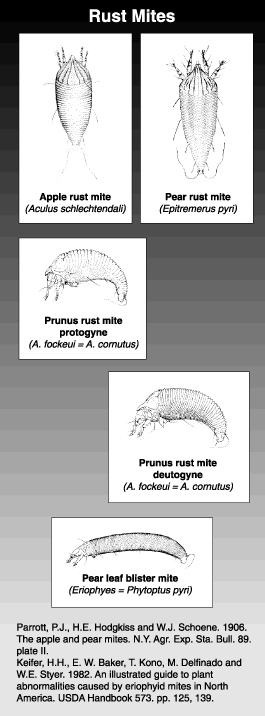 Adults
Adults
The adult mite is a typical eriophyid with two pairs of legs at the front and a cylindrical, annulate abdomen. The female is about 157 microns in length, slightly larger than the male. Newly emerged adults are a pale yellow color but turn brownish yellow or tan with age.
Life history
Prunus rust mites overwinter as diapausing females in buds (just beneath the outer scales) or in crevices of twigs and bark. Females leave their overwintering sites shortly after the buds begin to expand in the spring. After feeding for a few days, they begin to lay eggs. Females can lay 50 to 60 eggs, while males may deposit several hundred spermatophores. Eggs laid in spring may take up to 15 days to hatch but those laid in midsummer only 3 to 4 days. The immature stages require from 2 to 18 days to complete, with an average of 2.1 days for the larvae and 1.7 days for the nymphs. The life span of the adult is from 20 to 30 days. A complete generation requires 6 to 22 days, with the majority in the 7- to 12-day range. Generations are produced continuously throughout the summer.
When environmental conditions provide the appropriate trigger, usually poor condition of foliage, overwintering females (deutogynes) are produced. This may be as early as midsummer. Males die in the fall.
Females that are not inseminated produce only male progeny (arrhenotokous parthenogenesis), while those that are inseminated produce both male and female progeny.
Overwintering mortality of females may limit the population the following spring. Dry weather also appears to reduce mite populations, perhaps through the effect of hardening the leaves.
Damage
Mites feed on the surface of the leaf by piercing the epidermis with their mouthparts and sucking the fluids from the cells. Mature plum foliage attacked by Prunus rust mites may be curled or dwarfed. The lower leaf surface may be have a bronze or silvery appearance. On peach, the silver color is the predominant symptom. Feeding of mites on young foliage causes a toxemia which is called yellow spot on peach and chlorotic fleck on plum. As the names imply, the symptoms are small yellow spots on the leaves, followed by shotholing in some cultivars.
The impact of Prunus rust mites on yield or quality of their hosts has not been determined. It is probable that photosynthesis and transpiration are affected.
Monitoring
Prunus rust mites can be sampled by either examining the leaves with a hand lens or by brushing them off the leaves on to glass plates and counting them with the aid of a microscope (see the section on monitoring for European red mite).
Biological control
Predators include phytoseiid mites including Typhlodromus occidentalis in Washington, young nymphs of the anthocorid bug Orius insidiosus, and larvae of cecidomyiids. In the Pacific Northwest, it is likely that phytoseiid mites play the dominant role in biological control and that Prunus rust mites play a similar role as an alternate host to the tetranychid mites as do apple rust mites on apple.
Management
Prunus rust mites are not difficult to control by chemical means and are still susceptible to sulfur and specific miticides. Populations will be drastically reduced during hot, dry periods so a midsummer application is not advisable. However, rising populations in spring or fall may warrant treatment. Because of its role in integrated control, damage from Prunus rust mites should tolerated as long as possible. If other tetranychids are a problem and predator populations are building, leaving the rust mite population undisturbed may promote biological control of all mites. If a specific miticide is applied for the tetranychids, it will also reduce the peach silver mite population so no additional treatment is required. Peach silver mite may be controlled prebloom, during the summer, or postharvest, but the postharvest clean-up spray is favored because it reduces the overwintering deutogyne population and minimizes the effects on beneficial species. Treatments should be considered only when damage by this species is compounded by other types of foliar injury or environmental stress. Care should be taken that treatments are applied against an active and growing population of mites, as determined by successive samples, and not merely in response to bronzed or silvered leaves where populations have already dropped dramatically.
